Related Research Articles

The Battle of Lundy's Lane, also known as the Battle of Niagara, was fought on 25 July 1814, during the War of 1812, between an invading American army and a British and Canadian army near present-day Niagara Falls, Ontario. It was one of the bloodiest battles of the war, and one of the deadliest battles fought in Canada, with approximately 1,720 casualties including 258 killed.
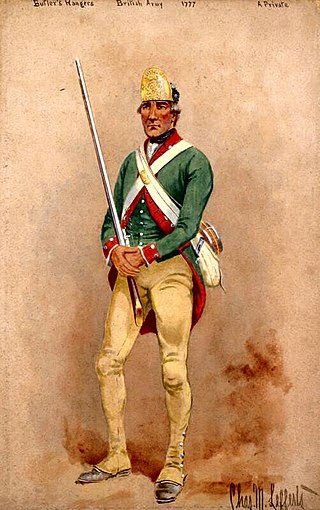
Butler's Rangers (1777–1784) was a Loyalist provincial military unit of the American Revolutionary War, raised by American loyalist John Butler. Most members of the regiment were Loyalists from upstate New York and northeastern Pennsylvania. Their winter quarters were constructed on the west bank of the Niagara River, in what is now Niagara-on-the-Lake, Ontario. The Rangers fought principally in New York and Pennsylvania, but ranged as far west as Ohio and Michigan, and as far south as Virginia and Kentucky.

The 4th Canadian Division is a formation of the Canadian Army. The division was first created as a formation of the Canadian Corps during the First World War. During the Second World War the division was reactivated as the 4th Canadian Infantry Division in 1941 and then converted to armour and redesignated as the 4th Canadian (Armoured) Division. Beginning in 1916 the division adopted a distinctive green-coloured formation patch as its insignia. In 2013 it was announced that Land Force Central Area would be redesignated 4th Canadian Division. It is currently responsible for Canadian Army operations in the Canadian province of Ontario and is headquartered at Denison Armoury in Toronto.

The 10th Canadian Infantry Brigade was a formation of the Canadian Army in both World War I and World War II. The brigade fought on the Western Front during World War I, and in Normandy and north-west Europe during World War II. It formed part of the 4th Canadian Division.
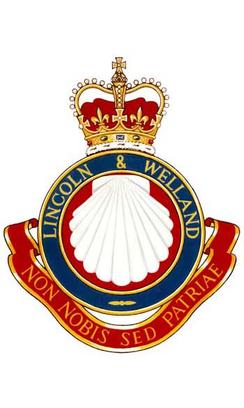
The Lincoln and Welland Regiment is a Primary Reserve infantry regiment of the Canadian Army based in St. Catharines and Welland, Ontario.

The Grey and Simcoe Foresters is a Primary Reserve infantry regiment of the Canadian Forces. Within the Canadian Army, it is part of the 4th Canadian Division's 31 Canadian Brigade Group. Due to the restructuring of the British Army, The Worcestershire and Sherwood Foresters Regiment was amalgamated into The Mercian Regiment, as its 2nd Battalion, leaving The Grey and Simcoe Foresters as the only remaining unit in the Commonwealth of Nations known to be distinctly designated as a regiment of Foresters.
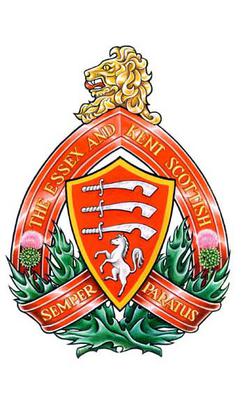
The Essex and Kent Scottish is a Primary Reserve infantry regiment of the Canadian Army.

The Algonquin Regiment (Northern Pioneers) is a primary reserve infantry regiment of the Canadian Army comprising two companies. A Company is located in North Bay, Ontario, and B Company is located in Timmins, Ontario. The regiment falls under the command of the 4th Canadian Division's 33 Canadian Brigade Group.

The 20th Battalion, CEF was a unit of the First World War Canadian Expeditionary Force.
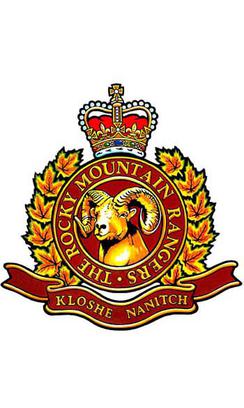
The Rocky Mountain Rangers is a Primary Reserve infantry regiment of the Canadian Army, one of only four infantry regiments in British Columbia, and the only infantry unit that recruits in Northern BC and much of the Interior. The regimental headquarters are at JR Vicars Armoury in Kamloops, with an additional rifle company in Prince George. The Rocky Mountain Rangers are part of the 3rd Canadian Division's 39 Canadian Brigade Group, the brigade responsible for Canadian Army organization in British Columbia.

The Queen's York Rangers (RCAC) is a Canadian Army Primary Reserve Royal Canadian Armoured Corps regiment based in Toronto and Aurora. The regiment is part of 4th Canadian Division's 32 Canadian Brigade Group. The regiment consists of one cavalry squadron, as well as the Headquarters and Training Squadron. The regimental family also includes The Queen's York Rangers Band (volunteer), along with two Royal Canadian Army Cadet corps and a Royal Canadian Air Cadet squadron. The unit mottos are pristinae virtutis memor – 'remembering their glories in former days' – and celer et audax – 'swift and bold'. Among its own members and those of other regiments, the unit is referred to as the Rangers. The name is abbreviated as QY Rang, and sometimes pronounced KWY-rang.
A ranger is typically either a caretaker that aids in the management of natural resources like public parks/forests or someone that works in a law enforcement or military/paramilitary role specializing in patrolling a given territory, called "ranging" or "scouting". The term most often refers to:
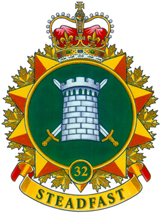
32 Canadian Brigade Group (32CBG) of the Canadian Army is part of the 4th Canadian Division. It is centred on the Greater Toronto Area, as well as Niagara Region and Brantford. It is headquartered at LCol George Taylor Denison III Armoury in Toronto, Ontario.

The 2nd/10th Dragoons was a militia regiment of the Canadian Army, based in the Niagara, Wentworth, and Brant regions of southern Ontario. It was formed in 1936 by amalgamating the 2nd and 10th Dragoons, both of which had served previously as cavalry units in the Canadian militia. After World War II the regiment was converted into an anti-aircraft artillery unit. In 1962 the regiment was converted into a field howitzer unit and in 1968 amid a downsizing of the Canadian Armed Forces the regiment was reduced drastically before eventually being completely disbanded in the mid-1990s. The regiment is currently on the Supplementary Order of Battle.
The 86th Battalion, CEF was an infantry battalion of the Canadian Expeditionary Force, which was raised for overseas service during World War I. Authorized on December 22, 1915, the battalion embarked for Britain in May 1916. Based at Shorncliffe, the battalion was reorganized as the Canadian Machine Gun Depot, CEF and provided reinforcements for Canadian units in the field until it was disbanded on 1 September 1917. It is believed to have been "the first of its kind in the British Empire."

98th Battalion, CEF, was an infantry battalion of the Great War Canadian Expeditionary Force. The 98th Battalion was authorized on 22 December 1915 and embarked for Britain on 16 July 1916, where the battalion provided reinforcements to the Canadian Corps in the field until 6 October 1916, when its personnel were absorbed by the 12th Reserve Battalion, CEF. The battalion disbanded on 17 July 1917.25
The 42nd Field Artillery Regiment, RCA is a Canadian Army Reserve artillery regiment based in Pembroke, Ontario. It is part of the 4th Canadian Division's 33 Canadian Brigade Group.

Frederic William Hill, CB, CMG, DSO, VD, QC was a Canadian lawyer and military officer.
The 2nd Dragoons was a cavalry regiment of the Non-Permanent Active Militia of the Canadian Militia. In 1936, the regiment was Amalgamated with the 10th Brant Dragoons to form the 2nd/10th Dragoons – today now part of the 57th Field Artillery Regiment, RCA.
The Lincoln Regiment was an infantry regiment of the Non-Permanent Active Militia of the Canadian Militia. In 1936, the regiment was Amalgamated with The Lincoln and Welland Regiment to form a new regiment also named The Lincoln and Welland Regiment.
References
- 1 2 3 Zavitz, Sherman (10 November 2007). "176th Rangers wrote proud chapter in city history". Niagara Falls Review. Archived from the original on 18 January 2017. Retrieved 17 January 2017.
- ↑ "The Lincoln and Welland Regiment". Official Lineages Volume 3, Part 2: Infantry Regiments. Directorate of History and Heritage. Retrieved 25 December 2015.